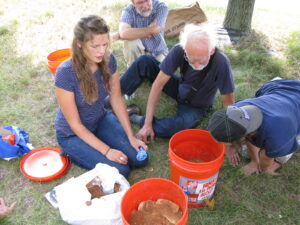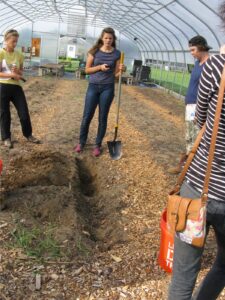2016 Annual Report for GNE15-098
Exploring the use of bokashi as a soil fertility amendment in Northeast vegetable production systems
Summary
Little is known about the characteristics and capabilities of bokashi as a soil fertility amendment. The goal of this project was to compare the use of bokashi made from food waste and Effective Microorganisms® inoculum to thermophilic compost and vermicompost as soil fertility amendments to grow spinach in greenhouse and field environments. The greenhouse experiment showed that bokashi (B) treatments had different fertility characteristics than thermophilic compost (TC), vermicompost (V) and control treatments, especially in terms of redox reactive nutrients NO3–-N –, Mn, and Fe, which is attributed to the anaerobic process used in its production. B treatments were characterized by initial high concentrations of NH4+, Mn and Fe, while V treatments were characterized by high initial NO3–-N – . However, by the conclusion of the experiment, NO3–-N – concentrations were greatest in B treatments, and V treatments had concentrations similar to control levels. Aboveground plant height and biomass of spinach in V and B treatments was greater than the control. This experiment suggested that B had a comparable performance to V in terms of nutrient supply and spinach growth. The field trial showed similar effects of B applications on N speciation and Mn and Fe concentrations as observed in the greenhouse experiment. Spinach from B treatments had significantly greater foliar concentrations of N, K, Mn, and Zn, as well as a significantly greater marketable yield than all other treatments at the second cutting of spinach (p<0.05). The field trial indicated that EM bokashi made from food waste may be a suitable supplemental or alternative soil fertility amendment in organic vegetable production systems. In both greenhouse and field trials, the soil microbial community in B treatments had a carbon substrate utilization pattern unique from all other treatments on the basis of principal coordinate analysis. These data suggest that bokashi applications affect the functional diversity of the soil microbial community.
Objectives/Performance Targets
- Objective 1: Compare the nutrient profiles, functional characteristics of the microbial community and the enzyme activity of bokashi with those of high quality, commercially produced thermophilic and vermicompost.
All of the tasks for this objective have been completed. We are expanding upon this objective by doing a another study comparing nutrient profiles and microbial community characteristics of bokashi made with different feedstocks.
- Objective 2: Evaluate the effect of bokashi on soil quality factors, soil enzymatic activity and nutrient composition post application.
Objective 2 has been met.
- Objective 3: Determine the effect of bokashi amendments on the growth of tomatoes and spinach.
CHANGE in objective details: switched to spinach crop for both greenhouse and field trials. This switch is reasoned by the fact that this project is aimed towards conducting research in a way that mirrors what a farmer would do on his or her own farm. Very few farmers grow tomatoes throughout the winter in a greenhouse, however spinach is a common winter crop. Also, winter tomato production may not be sustainable; lighting and temperature conducive to tomato growth in the winter require a lot of energy. Using spinach for both experiments is also more consistent, for experimental design and data analysis purposes.
This objective has been completed. Nutrient analysis of spinach leaf tissue and yield data was collected for both greenhouse and field trials.
- Objective 4: Supply extension agents and farmers with results from baseline bokashi study to catalyze further research and experimentation.
The following outreach efforts were made: Presentation to the UVM Farmer Training Program in October of 2015, information handouts were provided at the SARE booth at the NOFA-VT winter farming conference in February 2016, a bokashi workshop was held in August 2016, and poster presentation at the 2016 Soil, Agronomy, and Crop Science Society of America.
Accomplishments/Milestones
Over the past year we have completed all of the project objectives, and moving forward we plan to extend the project timeline to perform an additional study. Some changes were made to our approach, which I will describe here.
The spinach from the hoophouse trial did not survive the winter, therefore we chose to conduct a similar trial in the field over the spring and early summer of 2016. Over the winter however, we did conduct the greenhouse trial between January and March. The following months soil and plant nutrient, biomass, plant measurements, and soil enzyme activity analyses were conducted for the samples from the greenhouse trial. From this study we found that bokashi provided concentrations of N, P, and K to soil that are comparable to vermicompost and thermophilic compost. Spinach biomass was the greatest in bokashi and vermicompost treatments.
In May we set up the field trial and it concluded in July. During the summer months we collected plant and soil samples and conducted all of the nutrient and Biolog analyses. The field trial showed us that bokashi treatments had a more consistent supply of plant available nitrogen to the soil, and as a result spinach yields were greater during the second cutting and the plants had a higher concentration of important nutrients such as nitrogen, potassium, manganese, and zinc. We also conducted an economic analysis and found that though bokashi required more hand labor to produce and apply the plant available nitrogen and subsequent yield benefits it provided may counteract the additional labor. However we concluded that bokashi would be best suited for urban agriculture, gardeners, or small-scale vegetable farming.
At the conclusion of the field experiment, a bokashi workshop was held. In this workshop I demonstrated how to make and apply bokashi, provided supplemental educational materials and shared results from the field trial. I also presented a research poster at the Crops, Soils, and Agronomy Societies of America meetings in November.
Impacts and Contributions/Outcomes
This research addressed a gap in organic soil fertility research, as this is one of the first research projects focusing on the use of bokashi. We found that bokashi was characterized by high ammonium and low nitrate content and that its application to soil improved plant growth and yield. These results advance the knowledge of bokashi regarding its fertility potential and its effects on soil. I think that this has different applications in sustainability. Given legislation that aims to reduce food waste in landfills in the future, I see bokashi being a potential way for urban dwellers to transform food waste and use it in urban agricultural farms and gardens. Also, given the results of the economic analysis, it appears that bokashi could work in smaller- scale operations, though more studies should be done. I held a workshop in the summer to demonstrate how to make and use bokashi. Attendees were a combination of gardeners, farmers, educators and farmer training program students (see photos). Many attendees agreed and saw the value of bokashi in small scale systems.

Dana shows workshop attendants bokashi bran.

Dana shows attendees how to bury bokashi.
Though many of the results of this study was conclusive, there is still much to be learned about bokashi. It is our hope that by expanding the work to analyze different feedstocks that we could provide more information on the nutrient value that different food wastes provide in a bokashi product. Since there is so little information about bokashi in the United States, this study may serve as a baseline for more projects to build upon.
Collaborators:
Professor
Jeffords Hall
63 Carrigan Drive
Burlington, VT 05405
Office Phone: 8026569793